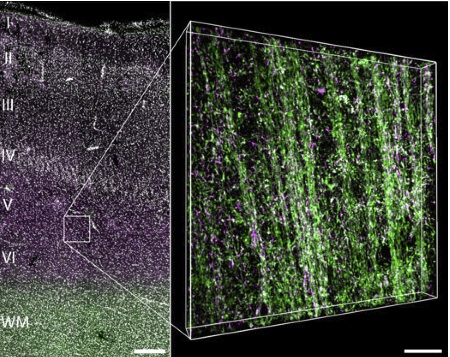Epilepsy at the Molecular Level

The detail of the cerebral cortext shows the myelin fibers that form an electrically insulating layer around the nerve cells (green/violet). Source: Cerebral Cortex/Oxford University Press
Why does a structural irregularity in the temporal lobe make humans more susceptible to epileptic seizures?
Experts have been searching for the answer to this question for a long time. A group of scientists at the Freiburg University Medical Center consisting of members of the University of Freiburg’s Cluster of Excellence Brain Links–Brain Tools has published a study involving a comparison of nearly 30,000 genes in the journal Cerebral Cortex.
The team describes pathological processes in the brain tissue in developmental disorders of the cerebral cortex. The study is the largest of its kind to date. The authors of the study see the research as an excellent example of cooperation between fundamental researchers and clinicians.
Pathological changes in the cerebral cortex referred to as “focal cortical dysplasias” are present in approximately 25 percent of epilepsies limited to particular brain areas. Patients with these dysplasias are often resistant to antiepileptic drugs. The most effective treatment is currently to remove the affected areas in an operation, after which the epileptic seizures generally stop happening.
Up to now, however, researchers could only speculate about how the abnormal structure of the cerebral cortex is linked at the molecular level to the occurrence of epilepsy. To investigate this connection, Freiburg neurobiologist Prof. Dr. Carola Haas and her team compared gene expression in malformed brain tissue with that in epileptic, non-malformed tissue.
To do so, they used so-called microarrays, a chip technology originally developed for the semiconductor industry. In this way, Haas and her colleagues succeeded in demonstrating that the factors less frequently expressed in diseased tissue are primarily those responsible for the formation of myelin. Myelin is an electrically insulating layer surrounding nerve cells. Additional analyses showed that the structure of this layer appears to be broken open and in disarray.
This could be an indication that the conduction of the stimuli is considerably impaired in the affected brain region. “The disposition for epilepsy in patients with the malformation investigated in our study could potentially be explained by a resulting electrical over-excitability of this nerve fiber sheath,” says Haas. The group at the Department of Neurosurgery now aims to conduct further experiments to investigate what precisely happens in the malformed tissue during the development of myelin.
Original publication:
C. Donkels, D. Pfeifer, P. Janz, S. Huber, J. Nakagawa, M. Prinz, A. Schulze-Bonhage, A. Weyerbrock, J. Zentner, C. Haas (2016): Whole Transciptome Screening Reveals Myelination Deficits in Dysplastic Human Temporal Neocortex. In: Cerebral Cortex., pp. 1–15.
Contact:
Prof. Dr. Carola Haas
Section for the Foundations of Epileptic Diseases
Department of Neurosurgery of the Medical Center – University of Freiburg
Phone: +49 (0)761/270-52950
E-Mail: carola.haas@uniklinik-freiburg.de
Levin Sottru
Science Communicator
Cluster of Excellence BrainLinks–BrainTools
University of Freiburg
Phone: +49 (0)761/203-67721
E-Mail: sottru@blbt.uni-freiburg.de
Weitere Informationen:
https://www.pr.uni-freiburg.de/pm/2016/pm.2016-02-09.18-en?set_language=en
Media Contact
All latest news from the category: Life Sciences and Chemistry
Articles and reports from the Life Sciences and chemistry area deal with applied and basic research into modern biology, chemistry and human medicine.
Valuable information can be found on a range of life sciences fields including bacteriology, biochemistry, bionics, bioinformatics, biophysics, biotechnology, genetics, geobotany, human biology, marine biology, microbiology, molecular biology, cellular biology, zoology, bioinorganic chemistry, microchemistry and environmental chemistry.
Newest articles

A ‘language’ for ML models to predict nanopore properties
A large number of 2D materials like graphene can have nanopores – small holes formed by missing atoms through which foreign substances can pass. The properties of these nanopores dictate many…

Clinically validated, wearable ultrasound patch
… for continuous blood pressure monitoring. A team of researchers at the University of California San Diego has developed a new and improved wearable ultrasound patch for continuous and noninvasive…

A new puzzle piece for string theory research
Dr. Ksenia Fedosova from the Cluster of Excellence Mathematics Münster, along with an international research team, has proven a conjecture in string theory that physicists had proposed regarding certain equations….



